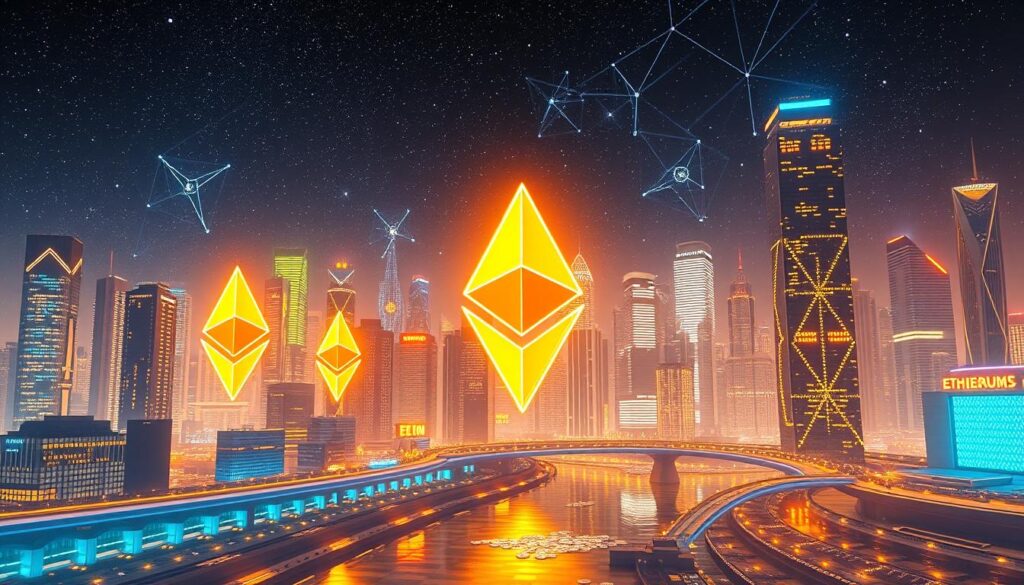Ethereum Overview: A Deep Dive Into the World’s Leading Smart Contract Blockchain
Ethereum Overview is essential for anyone seeking to understand how blockchain technology has evolved beyond Bitcoin. Since its launch in 2015, Ethereum has grown into the backbone of decentralized finance (DeFi), non-fungible tokens (NFTs), and decentralized applications (DApps). Unlike Bitcoin, which primarily acts as digital gold, Ethereum functions as a programmable blockchain — a decentralized global computer where code, not institutions, enforces trust.
This investigative breakdown explores Ethereum’s origins, key innovations, challenges, and future trajectory.
From Bitcoin to Ethereum: The Digital Currency Evolution
The Birth of the Blockchain Revolution
Bitcoin introduced the world to peer-to-peer digital money in 2009, sparking a movement away from traditional financial intermediaries. However, Bitcoin was designed with limited scripting abilities, restricting its role to value transfer.
Ethereum emerged as the next phase of blockchain innovation — a platform designed not just to move money, but to enable programmable agreements and applications.
Why Ethereum Matters Today
Ethereum allows developers to build decentralized systems that eliminate intermediaries, reduce costs, and enable global participation. It has also influenced government and institutional responses, with more than 130 countries now exploring Central Bank Digital Currencies (CBDCs).
Vitalik Buterin’s Vision: More Than Just Money
Ethereum’s story begins with Vitalik Buterin, a Russian-Canadian programmer who recognized blockchain’s potential beyond Bitcoin. In 2013, at just 19, he published the Ethereum whitepaper, proposing a decentralized “world computer.”
“Ethereum is not just a currency, but a decentralized world computer that can be programmed to perform a wide range of tasks.” – Vitalik Buterin
Ethereum’s architecture enabled a thriving ecosystem of smart contracts, NFTs, and decentralized governance — expanding blockchain into industries far beyond finance.
Smart Contracts: Ethereum’s Defining Innovation
What They Are
Smart contracts are self-executing agreements written in code. Once deployed, they run on Ethereum’s blockchain without the need for banks, lawyers, or centralized platforms.
Why They Matter
- Automation: Contracts execute instantly when conditions are met.
- Security: Immutable code prevents tampering.
- Transparency: Agreements are visible and verifiable on-chain.
Smart contracts form the backbone of DeFi, NFTs, and even gaming ecosystems — making Ethereum the infrastructure layer for Web3.
Decentralized Applications (DApps) on Ethereum
Ethereum has become the primary hub for DApps, hosting thousands of projects across finance, gaming, identity, and governance.
- Finance: Uniswap (DEX), Aave (lending), Compound (borrowing).
- NFTs: OpenSea, Rarible.
- Gaming & Metaverse: Decentraland, Axie Infinity.
Despite growth, DApps face persistent risks. In 2022 alone, over $48 billion was lost to hacks, though improved security reduced losses by 96% in 2023.
Ether (ETH): The Currency Powering Ethereum
Ether (ETH) is Ethereum’s native currency, used to pay transaction fees (“gas”) and incentivize validators. It also functions as a tradable digital asset, making it the second-largest cryptocurrency by market cap.
Key ETH facts:
- Supply cap: ~120 million ETH.
- Staking rewards: Validators earn ETH for securing the network.
- Volatility: Prices fluctuate sharply — peaking above $4,000 in 2021.
- Institutional adoption: Spot ETH ETFs were approved in 2024, signaling growing mainstream interest.
The Merge: Ethereum’s Shift to Proof-of-Stake
In 2022, Ethereum underwent “The Merge”, transitioning from energy-intensive Proof-of-Work (PoW) to Proof-of-Stake (PoS).
- Energy efficiency: Reduced energy consumption by 99.95%.
- Staking mechanics: Validators secure the network by staking 32 ETH.
- Accessibility: PoS lowers the barrier for participation compared to mining.
This shift positioned Ethereum as a sustainable blockchain leader, aligning with global ESG investment priorities.
ERC-20 Tokens and the Rise of DeFi
Ethereum’s ERC-20 standard revolutionized digital assets by enabling developers to create interoperable tokens. Today, more than 200,000 ERC-20 tokens exist, powering DeFi and beyond.
DeFi platforms leverage ERC-20 tokens for lending, trading, and yield farming — creating an open financial ecosystem accessible to anyone with an internet connection.
Ethereum’s Future: Opportunities and Risks
Growth Drivers
- Institutional adoption via ETFs and enterprise blockchain solutions.
- Scaling solutions like Layer 2 networks (Arbitrum, Optimism).
- Integration into global finance through tokenized assets and CBDCs.
Risks Ahead
- Regulation: Governments continue to debate crypto oversight.
- Competition: Rivals like Solana and Cardano challenge Ethereum’s dominance.
- Security vulnerabilities: Exploits remain a pressing concern.
Market analysts predict Ethereum could reach $11,800 by 2030 if adoption continues, though volatility makes long-term forecasting uncertain.
FAQ: Ethereum Overview
What is Ethereum and how does it work?
Ethereum is a decentralized blockchain platform that enables smart contracts, DApps, and digital asset creation. Its native cryptocurrency is Ether (ETH).
Why is Ethereum different from Bitcoin?
Unlike Bitcoin, which focuses on digital payments, Ethereum functions as a programmable blockchain, enabling applications beyond money.
What role does Ether (ETH) play in the Ethereum ecosystem?
Ether is used to pay for transaction fees, reward validators, and serve as a digital asset for investment and trade.
What was Ethereum’s “Merge”?
The Merge was Ethereum’s 2022 transition to Proof-of-Stake, cutting energy consumption by nearly 100% and making the network more sustainable.
How does Ethereum support DeFi and NFTs?
Through ERC-20 and ERC-721 standards, Ethereum powers decentralized finance platforms and NFT marketplaces, forming the foundation of Web3 innovation.
Conclusion: Ethereum at the Center of Web3
Ethereum Overview shows us a blockchain that is no longer just an experiment — it is the foundation of decentralized innovation. From smart contracts to DeFi and NFTs, Ethereum has built a digital economy that challenges traditional systems. Its shift to Proof-of-Stake marks a sustainable future, while Layer 2 scaling solutions aim to handle mass adoption.
The next decade will determine whether Ethereum remains the dominant force in Web3 or whether competitors seize its market share. Either way, Ethereum’s influence on digital finance and decentralized technology is undeniable.

